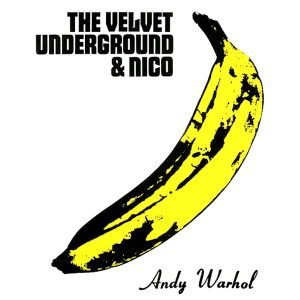Released in 1967, The Velvet Underground & Nico arrived as a defiant and radical statement, sounding nothing like the polished pop and rock standards of its time. This debut album from The Velvet Underground, co-created with the German chanteuse Nico and shaped under the mentorship of the avant-garde artist Andy Warhol, was less a commercial music release and more a multimedia manifesto. By blending raw, often abrasive music with Warhol’s visual aesthetics, the band presented an album that defied conventions, merging rock, art, and underground culture into a single, audacious work.
Artistic Intentions
Musically, The Velvet Underground & Nico veered away from the popular psychedelia of the late ‘60s. While bands like The Beatles and The Beach Boys explored lush sonic landscapes, Velvet Underground delved into stark minimalism and unpolished grit. This debut was an exploration of uncomfortable truths and hidden societal undercurrents, offering stories of addiction, sex, and urban alienation in New York City. The album’s confrontational style, rooted in both Lou Reed’s cynical songwriting and John Cale’s avant-garde sensibilities, pushed it far from mainstream appeal but etched it as a quintessential countercultural icon.
Lou Reed and the band sought to create an album that acted like a mirror to the underbelly of urban life, embodying themes that were almost taboo in popular music at the time. They portrayed what Warhol would call “the beautiful, the vulgar, the fascinating, and the boring,” in stark realism. The album’s intention wasn’t to merely entertain but to confront listeners with stark realities that most music avoided.
Warhol’s influence allowed them the freedom to experiment and provided the backing that gave Nico’s haunting voice and the band’s dissonant instrumentation room to flourish. In this way, The Velvet Underground & Nico transcended music alone, positioning itself as a daring piece of modern art that spoke as much to the listener’s sense of sight and thought as it did to their ears.
Sonic Exploration

The sonic landscape of The Velvet Underground & Nico is as raw and unfiltered as the subjects it tackles, casting a dark, provocative spell over the listener. Produced by Andy Warhol, along with Tom Wilson for later tracks, the album’s production values are anything but polished; in fact, it leans heavily into a gritty, lo-fi aesthetic. Instruments are sometimes starkly separate in the mix, creating a sense of space and tension that complements the album’s themes of alienation and urban decay.
Rather than aiming for pristine clarity, the production opts for a rugged, visceral edge that feels as though the listener is eavesdropping on a hidden corner of New York’s underground. This lo-fi approach doesn’t just suit the album’s mood—it heightens it, allowing the listener to feel the rawness of the music in a way that more polished production would have undermined.
Musical Arrangements
Musically, the arrangements are as unorthodox as they come, refusing typical song structures in favor of bold, experimental decisions. John Cale’s use of droning viola on tracks like “Venus in Furs” creates a haunting, dissonant atmosphere that’s equal parts disturbing and mesmerizing. It adds an avant-garde edge that directly contrasts with Lou Reed’s simple, narrative-driven guitar lines, which frequently follow almost monotone melodic patterns to accentuate the bleakness of the lyrics.
Drummer Maureen Tucker’s percussion is stripped down, with hollow beats and sparse cymbals that convey an eerie, minimalist pulse rather than a driving rhythm. Her style eschews standard rock drumming techniques, further intensifying the unsettling tone and delivering a rhythm that is more hypnotic than propulsive. Nico’s haunting, almost detached vocal delivery contrasts strikingly with Reed’s gritty vocals, especially on tracks like “All Tomorrow’s Parties,” where her voice floats over the band’s heavy, trance-like backing.
Genre Elements
In terms of genre, the album resists easy classification, though it’s often credited with shaping the roots of punk, post-punk, and alternative rock. Elements of folk, art rock, and proto-punk emerge, creating a hybrid sound that had little precedence in 1967. While tracks like “I’m Waiting for the Man” and “Run Run Run” feature rhythmic foundations similar to garage rock, they are stripped of typical rock ‘n’ roll polish, immersing them instead in a stark, urban grime. In contrast, “Heroin” oscillates between hushed moments and explosive crescendos, mirroring the highs and lows of its subject matter. These genre-blending explorations lay the groundwork for entire subcultures that would follow, including noise rock and goth.
Lyrical Analysis

The lyrics of The Velvet Underground & Nico delve into the gritty underbelly of urban life with an unapologetic realism that was rare in 1967. Rather than shying away from taboo subjects, Lou Reed’s lyrics confront addiction, desire, alienation, and existential malaise head-on, exploring life on the fringes of society with an almost journalistic candor. Tracks like “Heroin” and “I’m Waiting for the Man” depict scenes of drug dependency without romanticizing or condemning them; instead, they present these realities as they are, capturing both the ecstasy and the despair that coexist within addiction.
“Venus in Furs” taps into themes of fetishism and BDSM, inspired by the novel by Leopold von Sacher-Masoch, bringing a literary edge to the album’s exploration of deviance and human desire. Reed’s lyrics act as windows into the lives of characters often ignored by mainstream music of the time—transients, misfits, and seekers on the margins of society.
Lyrical Depth
The lyrical style is straightforward and narrative, yet layered with poetic subtext. Reed’s writing tends to tell stories, but his words carry a symbolic weight that invites deeper reflection. In “Heroin,” the line “When I’m rushing on my run, and I feel just like Jesus’ son” juxtaposes spiritual transcendence with the visceral experience of drug use, creating a striking contrast that lingers in the listener’s mind. Similarly, “All Tomorrow’s Parties” paints an almost cinematic portrait of a lonely woman at a party, dressed up but empty inside—a stark commentary on the hollow glamour that permeated much of Warhol’s Factory scene.
The lyrics do not guide the listener to neat conclusions; rather, they linger ambiguously, leaving room for interpretation. This open-endedness gives the album a sense of depth and mystery that allows listeners to connect with it in personal, sometimes visceral ways.
Emotional Impact
Emotionally, the album’s lyrics resonate with a potent mix of empathy, detachment, and confrontation. Reed’s words often feel observational, capturing scenes and moments with a nearly clinical precision, yet beneath this surface is a raw honesty that humanizes the characters he describes. In “I’ll Be Your Mirror,” for instance, Nico’s tender, vulnerable delivery adds a bittersweet softness to lyrics that speak of acceptance and compassion, offering a rare moment of warmth amid the album’s otherwise stark realism. Tracks like “Femme Fatale” evoke a detached melancholy, capturing the disillusionment and complexities of relationships in Reed’s own social circle, particularly around the world of Andy Warhol’s Factory.
Cohesion and Flow

The tracks on The Velvet Underground & Nico unfold with a loosely structured, almost cinematic progression, capturing the highs, lows, and raw intensity of life on society’s edges. While each song stands alone in its unique style and story, the album maintains an underlying sense of tension and alienation that ties it together. Opening with the jangly yet foreboding “Sunday Morning,” the album lures listeners in with deceptive sweetness before quickly shifting to more abrasive fare with “I’m Waiting for the Man.” This contrast between dreamy, almost pop-like elements and raw, abrasive rock introduces the unpredictability that will characterize the album as a whole, keeping listeners slightly off-balance as they move from track to track.
The sequencing also follows an emotional trajectory that reflects the chaotic lives of the album’s characters. Tracks like “Femme Fatale” and “All Tomorrow’s Parties” serve as haunting vignettes of emotional desolation, each presented with Nico’s detached, icy vocal style. As the album progresses into darker territory with “Venus in Furs” and “Heroin,” it dives deeper into themes of obsession, escapism, and despair.
These songs mark a shift from the observational narratives in earlier tracks to visceral, immersive explorations of psyche and desire. The placement of “Heroin” near the middle of the album is particularly poignant, as it serves as a climax of sorts—a chaotic descent that anchors the album’s intensity before moving into the more plaintive “There She Goes Again” and the hypnotic “I’ll Be Your Mirror.”
Thematic Consistency
The album achieves impressive thematic consistency, even as it explores different musical styles. The various elements—Nico’s haunting, minimalist vocals, Reed’s stark storytelling, Cale’s avant-garde instrumentation—repeat and reinforce themes of disillusionment, longing, and inner turmoil. Despite its range in sound and tempo, from the dirge-like “All Tomorrow’s Parties” to the hard-edged rock of “Run Run Run,” each song feels like an essential piece of the whole, contributing to an overarching narrative about life in the underground, both literally and metaphorically. By the time the final track, “European Son,” descends into chaos with its distorted, almost violent instrumental close, the album leaves listeners with a sense of unresolved tension, like a film that ends abruptly, leaving an open question.
Though the album is certainly eclectic, with styles that range from proto-punk to dreamy folk, its shifts are far from jarring. Rather, each change in tone feels deliberate, as though intended to mirror the varied, unpredictable landscape of the characters’ lives. Even the contrasts—between the softness of “Sunday Morning” and the intense energy of “European Son,” for example—ultimately serve to create a cohesive atmosphere of transgression and defiance. In its entirety, The Velvet Underground & Nico feels more like a curated collection of urban tales than a neatly packaged album, yet it achieves an undeniable unity through its persistent exploration of taboo, identity, and the human condition.
Standout Tracks and Moments
In an album packed with revolutionary sounds and daring themes, several tracks on The Velvet Underground & Nico stand out as emblematic of its artistic vision, pushing boundaries in ways that continue to resonate today.
Heroin
One of the most iconic is “Heroin,” which captures both the allure and horror of addiction in a way few songs had ever attempted. The track is structured around repetitive, almost trance-like chord progressions that build in tempo and intensity, mimicking the highs and lows of a drug rush. Lou Reed’s vocals shift between subdued and feverish, conveying a sense of euphoria and desperation. This track, with its violent crescendos and heart-racing shifts, is one of the album’s most powerful and innovative moments, placing listeners directly into the chaotic mind of its narrator.
Venus in Furs
Another standout is “Venus in Furs,” which explores themes of fetishism and desire with a brooding, haunting sound that’s hard to forget. John Cale’s droning electric viola creates a hypnotic, dissonant backdrop that feels both seductive and menacing. The lyrics, inspired by the 19th-century novel by Leopold von Sacher-Masoch, add a literary depth that was unusual for rock music at the time, merging high art with rock in a way that set a precedent for later experimental bands. The eerie, repetitive viola and Lou Reed’s detached vocal delivery make this track both unsettling and enthralling, giving it a timeless quality.
All Tomorrow’s Parties
“All Tomorrow’s Parties,” featuring Nico’s hauntingly aloof vocals, is another track that captures the album’s melancholy and introspective essence. The song unfolds as a commentary on the disillusionment and emptiness beneath the glamor of socialite life, particularly in the world of Warhol’s Factory. Nico’s voice floats above the persistent, pulsing instrumentation, adding an icy detachment that reinforces the song’s themes of isolation and existential despair. The use of piano here—stark, repetitive, and almost dirge-like—intensifies the song’s funereal mood, making it one of the album’s most memorable and emotionally impactful moments.
Sunday Morning
“Sunday Morning,” while lighter in tone, serves as a standout moment for its contrast and deceptive tranquility. The chiming celesta and Reed’s unexpectedly gentle vocals give the track a nostalgic, almost innocent feel. This song acts as a gateway into the album, luring listeners into a false sense of calm before they’re plunged into the darker themes that follow. Its reflective lyrics and dreamy melody provide a bittersweet contrast to the gritty realities explored in later tracks, making it a memorable and surprising opener.
European Son
Beyond individual tracks, the album has several unforgettable moments where sound and emotion fuse in groundbreaking ways. In “European Son,” the closing track, the song devolves into a chaotic, feedback-laden instrumental jam that exemplifies the band’s fearless approach to sound. The abrupt, shattering of a glass at the beginning of the track sets the tone, while the relentless instrumental frenzy that follows feels like a sonic embodiment of rebellion, frustration, and ultimate release.
Artistic Contribution and Innovation

The Velvet Underground & Nico occupies a singular place in the history of rock music, a work that not only pushed boundaries but actively redrew them. Released in 1967, the album emerged against the backdrop of the burgeoning counterculture movement and the “Summer of Love,” yet it stood in stark contrast to the optimistic psychedelia that dominated the era.
While contemporaries like The Beatles and The Byrds leaned into lush harmonies and melodic exploration, The Velvet Underground turned their gaze toward the shadows, offering a sonic and lyrical realism that felt closer to the gritty streets of New York City than to the technicolor utopias of California. Its impact on genres like punk, post-punk, noise rock, and alternative music is immeasurable, planting the seeds for countless bands who would draw on its ethos of artistic honesty and rebellion.
Rejection of Commercialization
The album’s disregard for commercial appeal and its focus on art over accessibility made it a commercial failure upon release, but it also cemented its legacy as a cult classic that resonated deeply with future generations of artists and listeners. Andy Warhol’s involvement brought a layer of avant-garde credibility, framing the album not just as a collection of songs but as an extension of the visual and conceptual art movements of the 1960s.
The album didn’t just push the boundaries of rock; it tore down the wall between music and high art, challenging the industry’s notion of what a rock album could be. Its influence became most evident in the punk and DIY movements of the 1970s and beyond, where raw, unfiltered expression and a disregard for mainstream trends became the hallmarks of new subcultures.
Production
In terms of innovation, The Velvet Underground & Nico was revolutionary in its approach to both sound and subject matter. The lo-fi, rough-edged production, which might have been seen as a flaw at the time, has since become a signature of authenticity in alternative music. It introduced the idea that a lack of studio polish could add to an album’s emotional impact, allowing the raw power of a song to come through without the sheen of overproduction. This approach directly influenced the rise of the DIY ethos in punk rock, where artists focused on the raw, unfiltered expression of their ideas over technical perfection.
Musically, the album’s blend of minimalist rock structures with avant-garde techniques was ahead of its time. John Cale’s use of the viola and experimentation with drone elements introduced a sense of dissonance and sonic texture that had rarely been heard in rock music. This fusion of rock and classical avant-garde elements became a blueprint for later experimental bands like Sonic Youth and Joy Division, who sought to create music that was challenging and confrontational rather than palatable. Tracks like “Venus in Furs” and “European Son” are prime examples of how the band used unorthodox instrumentation and dissonance to create an atmosphere that was both unsettling and captivating.
Themes
Thematically, the album’s blunt portrayal of drug use, sexual desire, and inner-city life was unlike anything in popular music at the time. Lou Reed’s lyrics didn’t shy away from taboo subjects, offering stark, unromanticized snapshots of the realities that the flower power generation largely avoided. This unfiltered storytelling not only paved the way for artists who would later explore similar themes, like Patti Smith and Iggy Pop, but also challenged the music industry’s tendency to sanitize the human experience. The Velvet Underground’s willingness to look at the darker aspects of life through an artistic lens fundamentally changed how rock music could be used as a vehicle for social commentary and artistic expression.
Closing Thoughts

The Velvet Underground & Nico is an album whose strengths lie in its fearless innovation, raw honesty, and willingness to push the boundaries of what rock music—and music in general—could express. It is an album that dares listeners to look into the darker sides of humanity and refuses to offer easy answers or comfort. The production may be rough around the edges, the melodies often unconventional, and the lyrics frequently jarring, but it’s precisely these qualities that give the album its visceral power. In embracing themes of alienation, addiction, and desire without flinching, it shattered the conventions of the 1960s music scene, offering a compelling, gritty alternative to the era’s glossy optimism.
In terms of weaknesses, one could argue that its unpolished production and experimental approach make it less accessible to mainstream listeners. Some tracks, like the dissonant, chaotic “European Son,” may come off as abrasive or overly avant-garde to unaccustomed ears. Yet, these same qualities—its rough sound, its dissonant moments—are what have given it staying power, allowing it to serve as a wellspring of inspiration for countless artists. The album’s willingness to dwell in discomfort and ambiguity is precisely what has kept it relevant and resonant across decades.
Place in Career
As both a debut and a cultural landmark, The Velvet Underground & Nico occupies a unique position in the band’s career and in rock history. It represents not just the beginning of The Velvet Underground’s journey but also the birth of an entirely new approach to rock music—one that embraced imperfections, explored taboo, and prioritized artistic truth over commercial appeal. For listeners, this album remains a rite of passage, a visceral journey into themes that mainstream music often shies away from, offering a reflection of life’s messier, more complex realities.
Official Rating
This album earns a perfect 10 out of 10 not for being flawless, but for being fearless. It’s an album that dared to be different and, in doing so, altered the trajectory of music forever. It stands as a testament to what art can achieve when it is unrestrained, challenging, and unwavering in its authenticity. The Velvet Underground & Nico remains a profound statement on the potential of rock music to go beyond entertainment and delve into the heart of the human experience—a work of art that refuses to fade or conform, just as vital today as it was upon its release.
